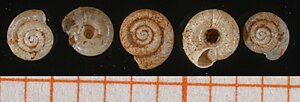False slice snail
| False slice snail | ||||||||||||
|---|---|---|---|---|---|---|---|---|---|---|---|---|

False pancake snail ( Hawaiia minuscula ) |
||||||||||||
| Systematics | ||||||||||||
|
||||||||||||
| Scientific name | ||||||||||||
| Hawaiia minuscula | ||||||||||||
| ( Binney , 1841) |
The false disk snail ( Hawaiia minuscula ) is a snail native to North America and the Russian Far East - a species of crystal snails (Pristilomatidae) in the suborder of land snails (Stylommatophora). It has now been anthropogenically displaced almost worldwide and occurs in Europe mainly in gardens, parks and greenhouses.
features
The right-hand wound, quite small case is flat, conical. In the side view, the thread is clearly raised. It has a width of 1.7 to 2.5 mm and a height of 0.7 to 1.2 mm. It has 3½ to 4½ turns that increase rapidly and regularly. The top of the turns is well rounded, the seam is deep. The underside of the turns is rounded. When viewed directly from above, the mouth is almost circular, apart from the small incision of the previous turn. The edge of the mouth is simple and tapering to a point. The surface of the mouth is only slightly oblique to the winding axis of the housing. On the upper side, the mouth edge is slightly saddle-shaped bent forward. The navel is wide and deep. It takes up about a quarter to a third of the diameter of the case. All previous turns are visible in the navel.
The skin is almost colorless to whitish, and thin and translucent. The surface is very fine and striped irregularly. They are crossed by distinct spiral lines. This gives the surface a dull, silky, non-shiny appearance.
In the hermaphroditic genital system, the spermatic duct (vas deferens) is moderately long. It penetrates apically into the spindle-shaped, long epiphallus. The proximal part is thick with a glandular wall, the distal part is more slender with a muscular wall. The penis is comparatively smaller and shorter than the epiphallus. This penetrates the penis subapically. Apically there is a small blind sac (caecum or flagellum) to which the penile retractor muscle attaches. Internally, the penis has long, axially extending folds. In the female tract, the free fallopian tube (oviduct) is very short and surrounded by the perivaginal gland. The vagina is also quite short. The stem of the spermathec is very long and thin, only thickly swollen at the base. The bladder is elongated, pear-shaped and lies against the protein gland (albumin gland).
Similar Art
The shell of the false disc snail looks very similar to that of the white disc snail ( Lucilla singleyana ). In general, however, the surface is rougher (stronger growth stripes), the shell is thinner and the seam is deeper, in each case in comparison to the white disc snail. In individual cases, however, the two types can only be distinguished by examining the genital apparatus and the radula.
Geographical distribution and habitat
The original range of the downy pancake snail is North America and the Russian Far East. It occurs there in a wide range of habitats. In Europe it was found in greenhouses in the Netherlands, Sweden, Germany, Poland, the Czech Republic, Slovakia, Austria, Italy and Greece, as well as in the British Isles (England, Scotland and Ireland).
Taxonomy
The taxon was first described by Amos Binney in 1841 as Helix minuscula after specimens from Ohio . As early as the 19th century specimens were brought to the Hawaiian Islands ( Kauaʻi ), where they were described again in 1854 by Lovell Augustus Reeve as Helix kawaiensis . This species is the formal type of the genus Hawaiia Gude, 1911. Since Helix kawaiensis Reeve, 1854 is a more recent synonym of Helix minuscula Binney, 1841, the latter is the de facto type of Hawaiia Gude, 1911. The taxon is generally recognized.
Danger
Vollrath Wiese notes a "threat of unknown extent" for this species. The IUCN , however, does not assess the stock situation of this species.
literature
- Michael P. Kerney, RAD Cameron, Jürgen H. Jungbluth: The land snails of Northern and Central Europe. 384 pp., Paul Parey, Hamburg & Berlin 1983, ISBN 3-490-17918-8 , p. 311/12.
Individual evidence
- ↑ a b c Vollrath Wiese: The land snails of Germany. 352 pp., Quelle & Meyer, Wiebelsheim 2014 ISBN 978-3-494-01551-4 (p. 198)
- ↑ Anatolij A. Schileyko: Treatise on Recent Terrestrial Pulmonate Molluscs Part 10 Ariophantidae, Ostracolethidae, Ryssotidae, Milacidae, Dyakiidae, Staffordiidae, Gastrodontidae, Zonitidae, Daudebardiidae, Parmacellidae. Ruthenica, Supplement 2 (10): 1307-1488, Moscow 2003, ISSN 0136-0027 , p. 1389.
- ^ A b Francisco W. Welter-Schultes: European non-marine molluscs, a guide for species identification = identification book for European land and freshwater mollusks. A1-A3 S., 679 S., Q1-Q78 S., Göttingen, Planet Poster Ed., 2012 ISBN 3-933922-75-5 , ISBN 978-3-933922-75-5 (p. 358)
- ↑ Amos Binney: A monograph of the helices inhabiting the United States. Boston Journal of Natural History, 3 (4): 405-438, Boston, 1841 Online at Biodiversity Heritage Library , p. 435 plate 22, fig. 4 .
- ^ Lovell Augustus Reeve: Conchologia Iconica: Or, Illustrations of the Shells of Molluscous Animals . Volume VII (= 7). 408 p., Reeve, London, 1854 Online at Google Books , plate CLXXXI (= 181)
- ↑ AnimalBase: Hawaiia minuscula (Binney, 1841)
- ↑ Fauna Europaea: Hawaiia minuscula (Binney, 1841)
- ↑ MolluscaBase: Hawaiia minuscula (Binney, 1841)
